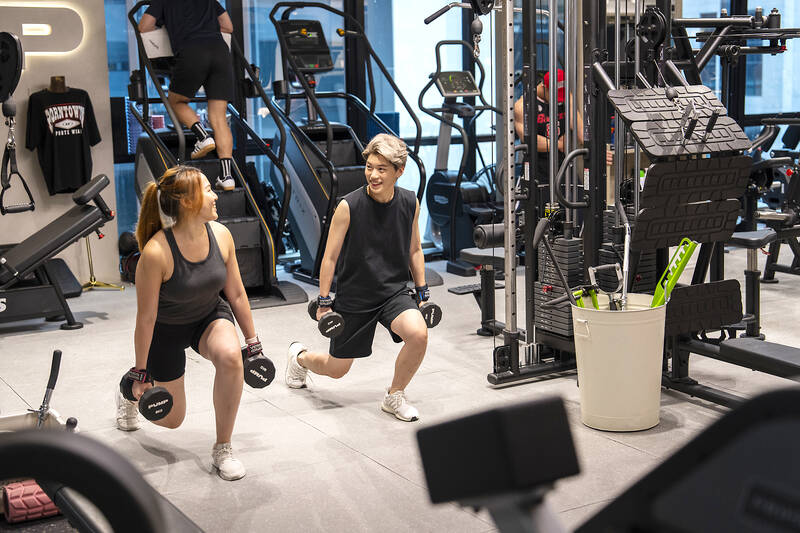Weightlifting is rapidly joining wild swimming, the Beckham family feud and lurching towards fascism as a national obsession. And with good cause. Also known as resistance training, pumping iron is about more than aspiring to look like a Love Islander. It’s been shown to boost your immune system, prevent cognitive decline and even reverse the aging process. More than your weight or BMI, increased muscle mass is considered one of the strongest indicators of longevity, with one decade-long study finding that it correlates with lower risk of death from all major causes. Unsure where to begin? We asked the experts.
WILL IT MAKE ME BULKY?
“This is a myth that has held women back for far too long,” says Elizabeth Davies, author of the forthcoming book Training For Your Old Lady Body: A No Bullsh*t Guide to Help Women Reframe Exercise. “For the majority of women, to build lots of visible muscle requires a hugely dedicated approach to your training and nutrition. It’s not something that just happens by accident. So please don’t let that be a reason not to start. If you find that you are developing more muscle than you’d like, just end your workout when you have a bit more left in the tank.”

Photo: AP
WHEN TO START?
“We used to believe that if children engaged in strength training it might stunt their growth, but that has been debunked,” Davies says. “We know now that if they are being supervised, then age-appropriate resistance training is safe and beneficial for children and adolescents, helping to improve their strength, build bone density, develop coordination and boost confidence.”
And weightlifting as an older person?
“It is true that an older muscle isn’t as responsive to weightlifting as a younger muscle, but that doesn’t mean you don’t get quite significant benefits,” says Leigh Breen, honorary professor of translational muscle physiology at the University of Birmingham. “Studies have shown quite dramatic improvements in muscle mass and strength in older adults who do strength training, with minimal to nonexistent adverse effects, even in those aged 90 and above.”
HOW OFTEN SHOULD YOU TRAIN
“Guidelines from the chief medical officer in the UK state that adults should aim to do at least two resistance strength training sessions a week,” Breen says. “There will be benefits if you can lift three or four times a week, but there’s a risk that you start to neglect aerobic exercise, which also has numerous health benefits.”
According to Nick Finney, a personal trainer whose clients have included Robbie Williams and J-Lo: “There’s nothing to stop you exercising every day, but you shouldn’t be lifting weights every day. You need recovery time in order for your muscles to adapt, so it becomes counterproductive to hit the same muscle groups day after day. If you love exercise, that’s not to stop you doing cardio or yoga or mobility on the days that you aren’t lifting. I always encourage people to get the most out of the minimum, and to be consistent. For most people it just wouldn’t be realistic to train for five or six days a week and keep that up for years.”
HOW MUCH TO LIFT?
“Generally, people should aim to lift between 70 percent and 80 percent of what we call their one repetition maximum (the load that they estimate they could move only once before they fail) for about 10 reps,” Breen says. “You can test this out. If, for instance, you can lift a weight 20 times at 50 percent effort, then your muscle is not working hard enough to grow. In that scenario, you would aim to increase the load until you can only manage 10 to 15 reps before you feel close to failure.”
Finney says: “If you want ultimate muscle growth, I like the final set to be five reps to failure — so that the last rep is a struggle. Prior to that you might have done a warmup set of 12 reps at a lower weight, and a middle set of eight reps at a medium weight. If you can manage eight reps on your final set, then you’re going too light.”
ARE REPS OR WEIGHT MORE IMPORTANT?
“Assuming you’d like to increase your muscle mass, what’s important is volume,” Breen says. “Your muscle doesn’t know how you place high demand on it, it just knows it’s fatigued. You can do this in one of two ways; either by lifting a heavy weight a few times or lowering the weight and doing more repetitions.”
Davies adds: “Heavier weights are more effective for building absolute strength — the most you can lift for a single rep, sometimes known as a one-rep max. So, if I was trying to build my deadlift to get as heavy as possible, I’d need to practice with fewer reps and heavy weights. Part of building strength is skill, and part of it is neurological adaptation. So you need to practice working close to your max in order for your nervous system to adapt.”
“There are different types of pain,” Davies says. “If you are performing a squat and your knee is hurting, I would reduce the weight, reduce your squat depth and see if that stops the pain. Often when we experience discomfort after a workout, this is delayed onset muscle soreness (Doms). This is really common when you do something novel; for instance, if you’ve ever tried a new class and been very sore the next day. It usually kicks in 24 hours after a workout, peaks on day two and is resolved after 72 hours.
“I really encourage people to stick with the same exercises for at least eight weeks, because there is something called the repeated bout effect, which means that once you start repeating the same stimulus on the body, the Doms vanishes, even when you’re increasing the weight or the reps.”
Breen concurs: “The idea that soreness is the catalyst to muscle growth is false. If you have an injury that doesn’t go away, that requires attention from a physiotherapist or other specialist.”
WHEN TO PROGRESS?
“The core principle of resistance training is progressive overload, which simply means doing more over time,” says Davies. “The body is really, really adaptable — and to keep it adapting, you have to keep gradually increasing that stimulus. The really important thing is to work with a rep range, because otherwise it’s going to be complete guesswork. For a beginner, a nice rep range could be six to 12 reps per set, using a weight that feels challenging enough for that rep range. A beginner might be increasing that load every single week, and then there’s going to be a point where things slow down a little bit. But the goal, even years into training, is always applying progressive overload.”

The Taipei Times last week reported that the rising share of seniors in the population is reshaping the nation’s housing markets. According to data from the Ministry of the Interior, about 850,000 residences were occupied by elderly people in the first quarter, including 655,000 that housed only one resident. H&B Realty chief researcher Jessica Hsu (徐佳馨), quoted in the article, said that there is rising demand for elderly-friendly housing, including units with elevators, barrier-free layouts and proximity to healthcare services. Hsu and others cited in the article highlighted the changing family residential dynamics, as children no longer live with parents,

It is jarring how differently Taiwan’s politics is portrayed in the international press compared to the local Chinese-language press. Viewed from abroad, Taiwan is seen as a geopolitical hotspot, or “The Most Dangerous Place on Earth,” as the Economist once blazoned across their cover. Meanwhile, tasked with facing down those existential threats, Taiwan’s leaders are dying their hair pink. These include former president Tsai Ing-wen (蔡英文), Vice President Hsiao Bi-khim (蕭美琴) and Kaohsiung Mayor Chen Chi-mai (陳其邁), among others. They are demonstrating what big fans they are of South Korean K-pop sensations Blackpink ahead of their concerts this weekend in Kaohsiung.

Oct 20 to Oct 26 After a day of fighting, the Japanese Army’s Second Division was resting when a curious delegation of two Scotsmen and 19 Taiwanese approached their camp. It was Oct. 20, 1895, and the troops had reached Taiye Village (太爺庄) in today’s Hunei District (湖內), Kaohsiung, just 10km away from their final target of Tainan. Led by Presbyterian missionaries Thomas Barclay and Duncan Ferguson, the group informed the Japanese that resistance leader Liu Yung-fu (劉永福) had fled to China the previous night, leaving his Black Flag Army fighters behind and the city in chaos. On behalf of the

I was 10 when I read an article in the local paper about the Air Guitar World Championships, which take place every year in my home town of Oulu, Finland. My parents had helped out at the very first contest back in 1996 — my mum gave out fliers, my dad sorted the music. Since then, national championships have been held all across the world, with the winners assembling in Oulu every summer. At the time, I asked my parents if I could compete. At first they were hesitant; the event was in a bar, and there would be a lot